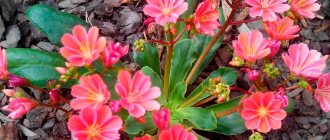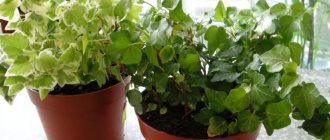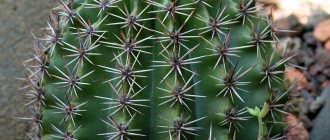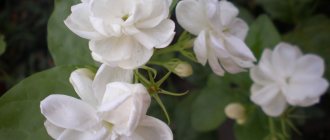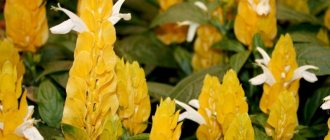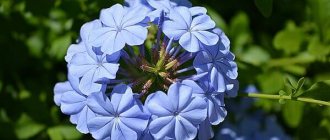Dracaena marginata is a fairly common flower, often found in our homes and offices.
Since the plant is practically indestructible, even a novice gardener can grow it, but from time to time he may make mistakes in care. Dracaena is native to the island of Madagascar, and it has a second name - “Dragon Tree”. Dear readers! For you, we have created communities on social networks in which useful articles and interesting ideas are published several times a day! Subscribe and receive useful content in a convenient format!
Caring for Dracaena Marginata after purchase
Immediately after purchase, the flower should be placed in a quarantine zone away from plants living at home.
This is done for the purpose if the flower is infected with pests or bacterial diseases, so that this does not spread to the rest of the plants in the house.
After the flower has adapted for two weeks in a new place, and the owner is convinced of the health of the purchased plant, you can begin replanting with a complete replacement of the soil.
This is done because the flower is planted in peat, which is very moisture-absorbing.
If you leave the flower in it, it is possible to fill the flower with water when watering. In addition, this soil is not nutritious, since it does not contain organic compounds.
Therefore, it is transplanted according to this recommendation:
- Remove the flower from the transport pot;
- Shake off the soil, lightly pressing it with your hands;
- Peat that has not fallen off freely can be removed using a stiff toothbrush, making combing movements from the root collar to the ends of the roots. In this case, you must not press too hard so as not to tear off the roots;
- After which the flower is planted in a new substrate “For palm trees”;
- The first watering is carried out with warm, settled water after 2-3 days.
Important! These procedures must be followed, since quarantining and completely replanting the plant can help keep it alive.
Replanting after purchase
After purchasing a plant from a flower shop, it is important to immediately inspect it in order to decide on the future fate of the tree. If the purchase took place in winter or autumn and the plant is in good condition and has enough land for growth, then replanting can be postponed until spring.
Usually a purchased flower requires replanting because:
the flower shop may have used unsuitable soil for the plant;- during the time that the flower spent on the store shelf, the soil could be depleted;
- perhaps the sellers did not adhere to the rules for caring for dracaena;
- the plant may already be cramped in the pot, as evidenced by roots sticking out of the drainage holes.
Even if, by all indications, the purchased flower requires an urgent transplant, it should be done no earlier than two weeks after purchase. This period is necessary for the dracaena so that it can fully adapt to the new conditions of detention.
If the flower was purchased in the spring, when all the plants begin to grow, then it can be replanted after two weeks of adaptation.
For successful transplantation, you need to prepare a suitable pot, good drainage and a new loose substrate.
Growing conditions
In order for Dracaena to grow and develop well, it must be provided with the necessary conditions for life.
Temperature
The best temperature indicator would be a range between 15-28 degrees Celsius . Dracaena can tolerate a drop in temperature to +11, but it is necessary to stop watering, since in cool conditions and high humidity it can become infected with root rot.
Air humidity
The plant does not depend much on air humidity, but in summer dry air the plant will need spraying or a warm shower twice a day. Otherwise, the tips of its beautiful leaves will begin to dry out from the dry air.
Also, when rinsing with a shower, dust is washed away from the leaf plates, which interferes with photosynthesis. In this case, the pot is wrapped in cellophane so that the soil does not get wet and there is no unnecessary watering.
Lighting
Direct sunlight in summer can burn the leaves, but at other times of the year Dracaena feels good standing on southern windows.
Therefore, in summer it is better to put it on a window sill facing any direction other than the south, or if there is no other window sill, then place it deep into the apartment, where there will be bright, diffused lighting.
In winter, the flower does not require lighting; natural light is enough for it.
In what cases is support needed?
In its normal state, this flower does not need support. But if Dracaena periodically lacks sunlight, it can grow thin and weak shoots.
In this case, it will need support, since the trunk may break off. The support is selected based on the height of the plant.
Choosing a place to put it
The ideal place for the plant is an east or west window. If the windows are oriented to the south, then starting in May, Dracaena is moved away from the window so that the summer sun's rays do not burn the leaves of the flower.
In an apartment facing north, the dracaena will not have enough sun in winter, and it will begin to grow weak stems, so they begin to illuminate it with special lamps for plants.
What does it look like in the interior?
These persistent plants are often used for indoor landscaping.
Because they have beautiful foliage and can withstand mismanagement.
They are displayed in groups when they are still small in stature or placed as a tapeworm if the palm tree has reached a meter mark.
Dracaena Marginata has variations in leaf mass and therefore you can purchase Dracaenas of different colors and display them in a bright corner of the room, which will give it a beautiful and memorable look.
General description of the plant
Dracaena marginata is a tree from the genus Dracaena of the Asparagus family.
The plant’s homeland is the island of Madagascar, which is why dracaena is often called the Madagascar Dragon Tree, because the word “dracaena” translated from Greek means “female dragon.” In Russia, it became an indoor flower and a favorite of gardeners, but under the name Margarita.
Wild plant specimens reach a height of 3 to 5 m, while domestic ones grow up to 1.5 m.
Visually, the Madagascar tree resembles a palm tree. It has a smooth, tree-like trunk, topped with a cap of foliage. The leaves are green, serrated and narrowly linear. Their length can reach up to 70 cm, and their width ranges from 2 to 4 cm. Some varieties have longitudinal stripes of green, white and even pink on the foliage, which gave rise to another name for the plant - bordered dracaena.
At home, dracaena blooms quite rarely. If this does happen, then the owner has to take the plant out of the room, since the aroma emitted by the flower of the tree is very pungent.
Transfer
The best time for transplantation is March-April - spring time before the onset of persistent heat.
Young plants are replanted annually, and older ones every 4 years or as needed.
Purchase the necessary soil and a container that will be slightly larger than the root system of the plant.
Dracaena with an inclined pot is easily removed from the soil, shaken off the old one and transferred to a new container with new nutritious soil.
The pot must be chosen exactly according to the size of the plant’s root system, otherwise in a pot that is too spacious there may be a risk of root rotting.
How to replant Dracaena marginalata?
One of the most common species grown by gardeners is Dracaena marginata. Caring for this plant will not be difficult even for novice gardeners. The main thing is to follow the standard rules for caring for tropical plants grown at home.
Soil requirements
Dracaena marginata is very demanding on the soil, which has a direct impact on its condition and development. Therefore, when replanting at home, it is recommended to take soil of very good quality and a strictly defined composition. It is best not to save money and buy ready-made soil mixture for dracaenas. Ideal for this plant would be a drained substrate with the addition of peat with an acidity in the range of 6-6.5 pH. It is not recommended to use ordinary garden soil. There are several reasons for this, one of which is the oversaturation of such material with nutritional components and mineral salts.
You can prepare the mixture for replanting dracaena yourself: mix 1 part turf soil, 2 parts leaf soil, 1 part compost and 0.5 parts peat in a ratio of 1: 2: 1: 0.5. To make the soil loose, you can add a handful of fine-grained river sand. When transplanting adult specimens, the pot is filled a quarter full with coarse sand.
Many lovers of indoor flowers have not learned how to choose the right flowerpots for their indoor pets. Often the human eye “falls” on something that looks aesthetically beautiful. But as it turns out later, the attractive appearance of a flowerpot does not mean its durability and practicality.
What container to choose for dracaena?
When choosing a container for transplanting at home, you need to adhere to some rules:
- The first thing to consider when choosing a new pot is the size of the plant's root ball. For example, for dracaena, whose height is about 45 cm, you need to take a pot with a diameter of at least 15 cm.
- For each subsequent transplant, it is recommended to use a container 3 cm in diameter larger than the previous one. Very often, inexperienced flower growers make a big mistake by buying a flowerpot for dracaena, so to speak, with a reserve. In such a flowerpot there will be constant stagnation of water, which will result in rotting of the roots of the plant and its death.
- You can replant dracaena into a ceramic, clay or plastic pot. It all depends on your wishes.
- For mature plants, stable, glass-shaped pots should be used.
- It would be good if there were perforated holes at the bottom of the container, which would avoid stagnation of water in the ground.
When to transplant, and what is necessary for this procedure?
Dracaena marginalata should be replanted at home in a timely manner; its further growth and development will depend on this. Therefore, competent care is very important here. This procedure is carried out in the spring. With the onset of autumn, the flower enters a resting phase, so it is not recommended to disturb it until spring.
To transplant Dracaena marginata at home you will need:
- Any pot, new or old, is 3 cm larger than the previous one.
- Soil for planting, purchased in a special store, or prepared at home.
- Drainage - expanded clay or broken ceramics are suitable.
- Sharp knife.
- Spray.
- Settled warm water.
At the bottom of the flowerpot, previously treated with boiling water, we place a 3 cm layer of drainage. If the container has perforated holes, the height of the drainage layer will be less. We remove the plant from the old pot. We free its roots from the old soil. We remove rotten and damaged roots, then spray them with a spray bottle. We place the flower in a new pot, sprinkling it with soil so that there are no voids between the roots. In order for the plant to take root better in the new soil, it needs to be watered with liquid ready-made fertilizer diluted 20 times with water.
Subsequent care for dracaena at home involves regularly moistening the soil. When the soil is first moistened, you can add Zircon twice a month.
Landing
The flower can be planted using seeds.
To do this, they are soaked in any growth stimulant at a temperature of +32 degrees, and kept for about a day. The seeds are planted in loose and nutritious soil, watered with warm water and placed in a place where the temperature is quite high.
You can place the pot near heating devices, but in this case you need to make sure that the soil does not dry out. After about a month, the seeds will begin to hatch, and when they reach 7 cm in height, they are transplanted into separate cups.
Important! Covering with glass or film will help retain moisture in the seed container.
Reproduction
Dracaena is propagated using:
- Cherenkov;
- Layers;
- Semyon.
The cuttings are the cut off top and can be propagated by placing them in water with the addition of activated carbon. After a while, roots form on the petiole and it is ready for planting.
Layering is when small shoots appear on a cut trunk. And when their number exceeds 4, they are grown and cut for reproduction. Seeds can be purchased at a specialty store and a beautiful Dracaena can be grown from them.
Rejuvenation
To rejuvenate an old plant, you need to carry out anti-aging pruning. Because over time, a young bush grows up to 3 m and a bare trunk with a panicle of leaves at the end does not always look beautiful.
By cutting such a flower, we will get several new shoots.
The crown shoot is cut off with a sharp knife or pruning shears, and the sections are powdered with wood ash. In order for the empty trunk to produce side shoots after pruning, it must be dried to avoid rot and a mini-greenhouse must be built in the upper part.
A microclimate with a humid environment is formed under it, which will stimulate the regrowth of side shoots. At the same time, watering is reduced so as not to provoke rotting in the cut part of the Dracaena.
When the young shoots begin to grow well, the greenhouse is removed and the plant continues to grow to 2-4 crowns. And after rooting, the cut top can be replanted in the same pot in the lower tier of the plant.
Important! If the side shoots on the cut part of the trunk keep themselves waiting, then the trunk is sprayed with Epin. This drug will enhance the formation of side shoots.
Watering
Dracaena prefers regular and abundant watering with warm filtered water.
When watered with cold water, the plant may experience shock and its leaves will begin to fall off, exposing the trunk.
Water it at such intervals that the soil has time to dry 3-4 cm deep.
After any watering, you need to carefully loosen the soil in the pot so that the roots of the Dracaena have access to oxygen and they can get enough of it.
In summer, the plant is watered approximately once a week, and in winter once a month.
Important! It is better to underwater the plant than to overwater it, as the plant may die from too much moisture.
Tree propagation
Dracaena is always propagated in the spring. For this purpose, the top of the shoot remaining after pruning, stem cuttings from 10 to 15 cm long, air layering and children that grow at the base of an adult plant are suitable.
Step-by-step description of the dracaena propagation process:
- Use a sharp knife to cut off the top of the plant or cut off part of the stem.
- The fresh cut is dried for one to two days by wrapping it in a paper towel or gauze. It is then treated with a root stimulating agent.
- The prepared cuttings are placed in purified and settled water for a month. During this time, it will produce roots, which will allow the dracaena to be planted in the ground.
It should be noted that some gardeners prefer to plant cuttings in the ground immediately after treatment with a composition that stimulates root formation. In this case, the soil is made up of sand, peat, pieces of charcoal and sphagnum. Plants that take root best are those that are given greenhouse conditions using a glass jar or polyethylene.
In the future, young trees are replanted every 2-3 years.
To do this, a layer of drainage is placed in a pot with a slightly larger diameter than the previous one, on top of which a light, well-aerated soil is placed, for example, a ready-made mixture for palm trees and dracaenas. Then the earthen lump of the plant is carefully transferred there and sprinkled with the remains of the soil.
Top dressing
Since dracaena is an ornamental deciduous plant, its fertilizing should be characterized by a large proportion of nitrogen substances, which serve to grow the green part of the plant.
Therefore, they purchase fertilizers for decorative flowers and water the plant twice a month in the summer, and once a month in the winter at half the dosage.
The correct dilution of the fertilizer should be indicated on the fertilizer packaging itself and you should not move away from it.
Important! Fertilizing is applied only to moist soil after watering, so that the Dracaena root system does not burn.
Diseases and pests
If not properly cared for, a scale insect or mite may appear on Dracaena, and to get rid of it, you need to purchase Actellik and spray the flower three times with an interval of 7 days.
If spots of rot or fungal disease appear, the flower must be sprayed with an appropriate fungicide.
We must remember that you need to inspect the plant for the presence of pests or infections once a week, since it is easier to get rid of a disease noticed in time than when the entire flower is already affected.
Important! The dilution method is given in the instructions and does not need to be changed.
How to resuscitate?
The plant trunk became soft and wrinkled
The dracaena has been flooded too much for a long time and it needs to be cut back to the place where the trunk has good turgor and put it on propagation.
There are small brown spots on the leaves
Consequence of the Bay. You need to remove the flower from the ground and examine the roots. Cut off everything rotten and replant in new soil. After which you need to adjust the watering by reducing it.
Almost all the leaf blades on the plant have fallen off, leaving only two at the very top. How to fix the situation?
Remove the plant from the soil and inspect the root system. If black or empty roots are found, they are cut off and the remaining ones are sprinkled with activated carbon. After which the Dracaena is planted in a small container according to the size of the root system and is not watered for 2 weeks. And only then they begin to carefully water with warm water and not much at a time.
My trunk is wrinkled from the ground and small midges fly just above the ground. What is this?
Most likely, Dracaena is flooded and requires urgent transplantation into new soil. Therefore, it is removed from the soil, the roots are examined and damaged ones are removed. If there are sufficient remaining roots, the flower is planted in new soil. If there are practically no more roots, the trunk is placed in water to build up the root system.
They gave me Dracaena as a gift, but while I was taking it home, it probably froze, and black spots appeared on the leaves.
Black spots cannot be cured and if they are located on the lower leaf blades, then over time they will disappear due to old age. If the growing point is damaged (frozen), the flower may die. Also, after purchase, after 2 weeks, you need to transplant the flower into the required substrate and inspect the root system.
Magic properties
The flower has become especially popular in China; in this country it is called “bamboo happiness.” The energy of dracaena ensures the financial well-being of the residents of the house and attracts positive energy, helps in love and friendships and gives people long life.
Dracaena has a calm character. Lush foliage on a bare shoot symbolizes organization and orderliness. The flower helps clear thoughts of negativity. It is worth noting the positive effect of the plant on human health - the leaves of Dracaena Marginata help wounds heal faster and resist skin diseases. The energy of the plant has a beneficial effect on the musculoskeletal system, as well as on the condition of the teeth.
According to Feng Shui, dracaena should be placed near the front door, in this way the owners of the house express their respect for the guests and wish them all the best. Dracaena is considered an ideal gift for loved ones. The number of shoots is also symbolic:
- three - attracts happiness;
- five - gives financial security;
- seven - improves health;
- twenty-one - ensures success in all matters.
There are compositions consisting of 20 twisted stems. They are called the "Tower of Love".
Answers to popular questions
Why do the leaves dry out?
If the lower leaves dry out and the flower sheds them, this is natural aging of the foliage. If the tips of the leaf blades dry out, this indicates dry air.
When does it bloom?
Dracaena will bloom with regular mineral feeding and proper care.
Why do leaf blades turn black?
This indicates that the flower has problems with the root system. Therefore, she dries off the excess leaves. To help it, it is removed and placed in water to build up the root mass.
Is it possible to plant 2-3 Dracaena growths in one container?
It is possible, but they will look beautiful if they are of different heights. Since if the tops of the heads are at the same height, they can oppress each other.
The most popular varieties
Dracaena Martinata is one of the few species of Madagascar tree that can be cultivated indoors. The following varieties of this flower are especially popular among gardeners:
- Marginata is a natural species with a reddish-purple border around the edge of the green leaves.
- Bicolor - the variety is characterized by peculiar narrow foliage with beautiful longitudinal stripes of pink color.
- Tricolor - this variety is distinguished by leaves with narrow red and yellow stripes, creating a golden-green coloring effect.
- Colorama - This variety has the lightest foliage with a wide red border.
- Magenta or Magenta - plants of this variety have bright green foliage with crimson edging.


